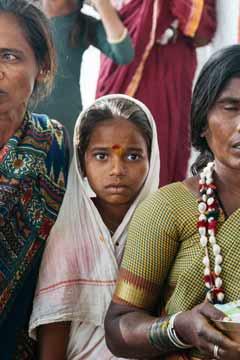Broken Lives: Slavery in Modern India

New exhibition reveals experiences of India’s Dalit community
A powerful new exhibition, Broken lives: Slavery in modern India, opening on 26 June 2015 at the International Slavery Museum in Liverpool, provides a glimpse into the experiences of India’s Dalit community.
This is the first ever exhibition to look specifically at the modern slavery and human trafficking of Dalits in India.
The word ‘Dalit’ means broken, crushed or oppressed.
Dalits were known formerly in India as ‘Untouchables’, because many avoided physical contact with them for fear of tainting their own religious purity or social superiority. Although Untouchability was outlawed by the Indian constitution, the practice still persists in some parts of the country today.
Dr Richard Benjamin, Head of the International Slavery Museum, said:
“This exhibition reveals that many forms of slavery and enslavement still exist around the world.
“Up to half of the victims of modern slavery globally are in India, where as many as 14.3m people are affected, with the majority being Dalits. Many experience marginalisation, prejudice, live in extreme poverty and may be vulnerable to human trafficking and bonded labour.
“We want to raise awareness of this modern day issue. And we want to go beyond that. There is a strong call to action at the end of this exhibition. Together we can actually make a difference.”
Revealing the Dalits’ stories of hardship, survival and hope for broken lives mended, the exhibition includes moving photography, film and case studies. Importantly, visitors find out how to make a difference.
Upon arrival, visitors will be able to learn about the lives of Dalit people through three different displays within the exhibition:
• The brick kiln – to see how poverty, illness and natural disasters can lead to debt slavery. One of the case studies features 14 year old Selva, forced to work as a ‘loader’ in a food market as payment for his parent’s loan. After four years, he managed to escape by hiding in a toilet on a train. This section also features Oscar-nominated short film ‘Kavi’, a fictional account of child bonded labour in India, which reflects reality for hundreds of thousands of children in the country.
• The cotton mills – to see how women and young girls are exploited in the garment industry to produce clothes destined for sale in the UK and the rest of Europe.
• The dedication ceremony – to discover how and why some Dalit girls are forced into a lifetime of ritual sex slavery and abuse. Visitors can learn about seven year old Jayamma who, as a Jogini, had to make herself available for sex with any man that approached her on reaching puberty. By 13 she was pregnant and, in her twenties, became ill and received tests and treatment with the help of the Dalit Freedom Network for HIV.
The exhibition has been developed in partnership with the Dalit Freedom Network, who work to prevent the human trafficking and modern slavery of Dalits and others from poor and marginalised communities through education, healthcare and economic empowerment.
Jeeva Kumar, Director of Pratigya India, Dalit Freedom Network’s Indian partner, said:
“The exhibition provides a window into the experiences of Dalits, who are 27 times more likely to be exploited in modern slavery than anyone else in India.
“Many Dalits already feel excluded, unable to access education, healthcare and justice. In some areas, they may still be prevented from entering public parks, temples, or even getting drinking water from the village pump. Often they have the most menial, dehumanising jobs. This exhibition highlights exploitation in some brick kilns and cotton mills, or child abuse in the name of tradition.
“This is a modern day injustice. But visitors can help”.
For more details: www.liverpoolmuseums.org.uk/brokenlives Twitter: #brokenlives
Notes to editors
* Dalit – throughout this exhibition, the word Dalit includes both scheduled castes and scheduled tribes (Adivasis – India’s indigenous tribes)
** The Global Slavery Index 2014 estimates 14,285,700 in modern slavery in India.
About International Slavery Museum
The International Slavery Museum opened in August 2007. It is situated on the third floor of the Merseyside Maritime Museum at the Albert Dock. It is the only national museum in the world to cover transatlantic slavery and its legacies as well as modern forms of slavery and enslavement. It is also an international hub for resources on human rights issues and campaigning.
About National Museums Liverpool
National Museums Liverpool comprises eight venues. Our collections are among the most important and varied in Europe and contain everything from Impressionist paintings and rare beetles to a lifejacket from the Titanic. We attract nearly 2.7m visitors every year. Our venues are World Museum, Museum of Liverpool, the Walker Art Gallery, Merseyside Maritime Museum, International Slavery Museum, Border Force National Museum, Sudley House and the Lady Lever Art Gallery.
About Dalit Freedom Network
Dalit Freedom Network UK is part of an international response to requests from Dalit leaders in India to educate their children and help protect their women from exploitation. As a trafficking prevention organisation, Dalit Freedom Network UK raised awareness in the UK and supports on-the-ground anti-trafficking, education, economic empowerment and healthcare programmes to bring about community transformation. www.dfn.org.uk
